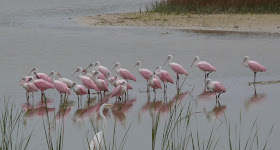I received an invitation to join up with Bob Pelkey for an early morning visit to Harn's Marsh on this Monday. I could not get get off from work till 7 AM and after working twelve straight night shifts, was too exhausted to attend till after some sleep. So I did not get there till after 1 PM. Bob was already gone by then, but not the birds.
 |
| Sandhill Cranes located at Harne's Marsh |
The draw-down on the water level in the marsh, just like our entire region, as we are waiting on the start of the rainy season, has concentrated the wading birds on the shrinking pools. The small lake adjacent to the parking area at the 38th W Street entrance was shallow and had concentrations of Limpkins, numbering around 30 birds.
 |
| Crane is vocalizing as it is being harassed by nesting Black-necked Stilts |
 |
| Roseate Spoonbills |
 |
| American White Pelicans |
These large concentration of birds included over fifty Mottled Ducks, forty Roseate Spoonbills, fourteen Sandhill Cranes including a family with a pair of half-grown colts. With the food supply being concentrated in the shrinking pools hundreds of wading birds including Great Egrets, Great Blue Herons, Snowy Egrets, Tricolored Herons, White and Glossy Ibis, Wood Storks, Roseate Spoonbills, Little Blue Herons and a couple of dozen American White Pelicans are found.
I was interested in locating black-bellied whistling ducks which seemed to becoming more common here. I had a flock of fourteen last month and Bob Pelkey and other photographers have been getting photos of these ducks in flight. I explorer for about five miles of the marsh , accessing from both the 38th Street W and the Harn'sMarsh Elementary School location. I did not locate any of the whistling ducks and only four Snail Kites. Found about eight paired off Black-necked Stilts. Only other shore birds included a Greater Yellowlegs and four Killdeer. Just the day before white-rumped sandpipers (uncommon in our area) had been seen. Other recently seen shore birds included stilt, pectoral, least, and semipalmated sandpipers, plus lesser yellowlegs and semipalmate plover. One pair of nesting Black-necked Stilts were observed mobbing a pair of Sandhill Cranes approaching too close the nest.
Other species observed included Red-winged Blackbirds, both Grackles, Black-crowned Nightheron, Black and Turkey Vultures, Pied-billed Grebe, Cormorant, Anhinga, Bald eagle, Swallow-tailed Kite, Common Moorhen, Fish Crow, Pileated Woodpecker, Parula Warbler, Green Heron, Red-shouldered Hawk, Mourning Doves, Great Crested Flycatcher and Northern Cardinals.
The decline in the Snail Kite numbers represents the decline in there food source, the apple snail, caused by the shrinking marsh. Hopefully they can find enough food elsewhere and return in better days. A recent newspaper article posted how severally the snail kites population suffers when we experience extended droughts.

No comments:
Post a Comment